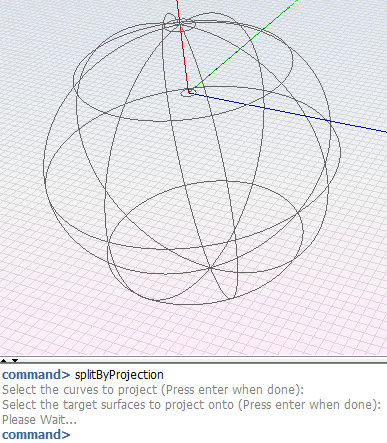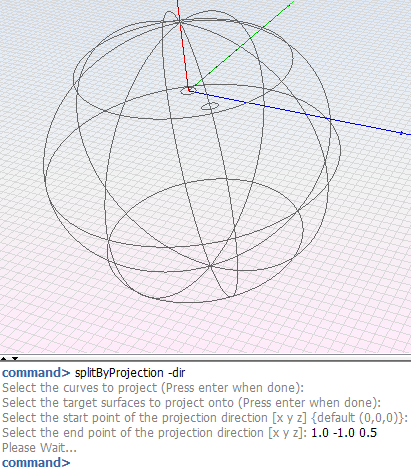splitByProjection
This command projects curves onto surfaces or objects and split them with the resulting projections. The projected curves are only used to split the target surfaces and they are not included to the geometry.
Inline mode usage
- splitByProjection -h
- Displays the help file that summarizes the parameters for this command.
- splitByProjection -s <nameCurve1> <nameCurve2> ... –targets <nameSurface1> <nameSurface2> ...
- Project the selected curves onto the closest points of the target surfaces selection and then the surfaces are split.
- splitByProjection -s <nameCurve1> <nameCurve2> ... –targets <nameSurface1> <nameSurface2> ... -dir <startX> <startY> <start> <endX> <endY> <endZ>
- Project the curves onto the target surfaces selection according to the vector defined by the differences <endX-startX> <endY-startY> <endZ-startZ> and then the surfaces are split.
Interactive mode usage
- Invocation
- splitByProjection or splitByProjection -dir
- Parameters
-
- Curves to project. Selection of curves to be projected. They are not modified and the projected curves are not generated in the geometry.
- Target surfaces. Selection of surfaces and objects to be split by the projected curves.
- Start point. Origin of the projection direction. This parameter is only required when the option -dir is included in the invocation.
- End point. End of the projection direction. This parameter is only required when the option -dir is included in the invocation.
Example
We’re going to split a sphere with the projection of a circle by using the two different modes.
The next commands create the objects required for the projection.
command> circleCenter [x y z]: 0 0 0Radius [double]: 0.1command> sphereSelect center [x y z]: 0 0 -1Radius [double]: 2command> If no options is included in the invocation, the project to the closest point is done. This projection may modify the dimensions of the resulting curves.
If the option -dir is included in the invocation, two points are required to define the projection direction.
Results

